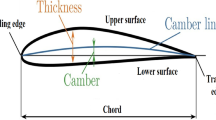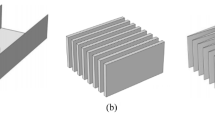Abstract
The use of airfoils that describe heave and pitching movements simultaneously to extract energy from oncoming fluid, as a turbine, is one of the promising concepts in renewable energy. In the present study, the efficiency of two airfoils or “wings” such as NACA 0020 and NACA 1412 to extract energy from oncoming water is investigated while they move through steady laminar (Re = 735, Re = 1100). Ansys Fluent is the software used for simulating in which a programming code in C language is developed and applied to airfoils in order to achieve the oscillatory movement. By other side, theory of feathering parameter χ > 1 is applied as a necessary condition for power-extraction regime. Therefore, values between 1 < χ < 2.5 were tested. In addition, the study of effects on parameters when vary nondimensional frequency 0 < f∗ < 0.30 and heaving amplitude 0.25 · chord ≤ H0 ≤ 1 · chord, when Re = 735, and pitching axis is located at 33% of the chord length are presented as well as a mapping of efficiency for both airfoils. The results obtained due to variation on parameters are discussed, hoping to have an efficiency greater than 10% for both airfoils and greater than 30% when Ho/chord = 0.5.
Access this chapter
Tax calculation will be finalised at checkout
Purchases are for personal use only
Similar content being viewed by others
References
Xiao, Q., & Zhu, Q. (2014, April). A review on flow energy harvesters based on flapping foils. Journal of Fluids and Structures, 46, 174–191. https://doi.org/10.1016/j.jfluidstructs.2014.01.002
Zhu, Q. (2011, May). Optimal frequency for flow energy harvesting of a flapping foil. Journal of Fluid Mechanics, 675, 495–517. https://doi.org/10.1017/S0022112011000334
Kinsey, T., et al. (2011, June). Prototype testing of a hydrokinetic turbine based on oscillating hydrofoils. Renewable Energy, 36(6), 1710–1718. https://doi.org/10.1016/j.renene.2010.11.037
Kinsey, T., & Dumas, G. (2008, June). Parametric study of an oscillating airfoil in a power-extraction regime. AIAA Journal, 46(6), 1318–1330. https://doi.org/10.2514/1.26253
Betz, A. (2013, August). The maximum of the theoretically possible exploitation of wind by means of a wind motor. Wind Engineering, 37(4), 441–446. https://doi.org/10.1260/0309-524X.37.4.441
McNeel, R., et al. (2010). Rhinoceros 3D, Version 6.0. Robert McNeel & Associates.
Swanson, J. (2020). Ansys, 2020 R1. NASDAQ. [Online]. Available: https://www.ansys.com/academic/students
Cadence. (2020). Compute Grid Spacing for a Given Y+. pointwise.com. https://www.pointwise.com/yplus/index.html. Accessed 23 July 2021.
Versteeg, H. K., & Malaladekera, W. (2007). An introduction to computational fluid dynamics (2nd ed.). Pearson Prentices Hall.
Blazek, J. (2015). Computational fluid dynamics: Principles and applications (3rd ed.). Elsevier.
Ansys Training. (2019). Ansys fluent dynamic mesh modeling. Virtual – WebEx. [Online]. Available: https://www.ansys.com/training-center/course-catalog/fluids/ansys-fluent-dynamic-mesh-modeling
ANSYS Inc. (2013). Ansys fluent theory guide (15th ed.). ANSYS.
ANSYS Inc. (2012). Monitoring residuals. In ANSYS FLUENT 12.0 User’s guide. https://www.afs.enea.it/project/neptunius/docs/fluent/html/ug/node812.htm. Accessed 1 Sept 2021
Author information
Authors and Affiliations
Corresponding author
Editor information
Editors and Affiliations
Rights and permissions
Copyright information
© 2022 The Author(s), under exclusive license to Springer Nature Switzerland AG
About this paper
Cite this paper
Gonzaga-Bermeo, L., Cuenca, C.A. (2022). Analysis of Two-Dimensional Airfoil Models as Harvesters of Energy. In: Espinoza-Andaluz, M., Andersson, M., Li, T., Santana Villamar, J., Encalada Dávila, Á., Melo Vargas, E. (eds) Congress on Research, Development and Innovation in Renewable Energies. Green Energy and Technology. Springer, Cham. https://doi.org/10.1007/978-3-030-97862-4_7
Download citation
DOI: https://doi.org/10.1007/978-3-030-97862-4_7
Published:
Publisher Name: Springer, Cham
Print ISBN: 978-3-030-97861-7
Online ISBN: 978-3-030-97862-4
eBook Packages: EnergyEnergy (R0)




